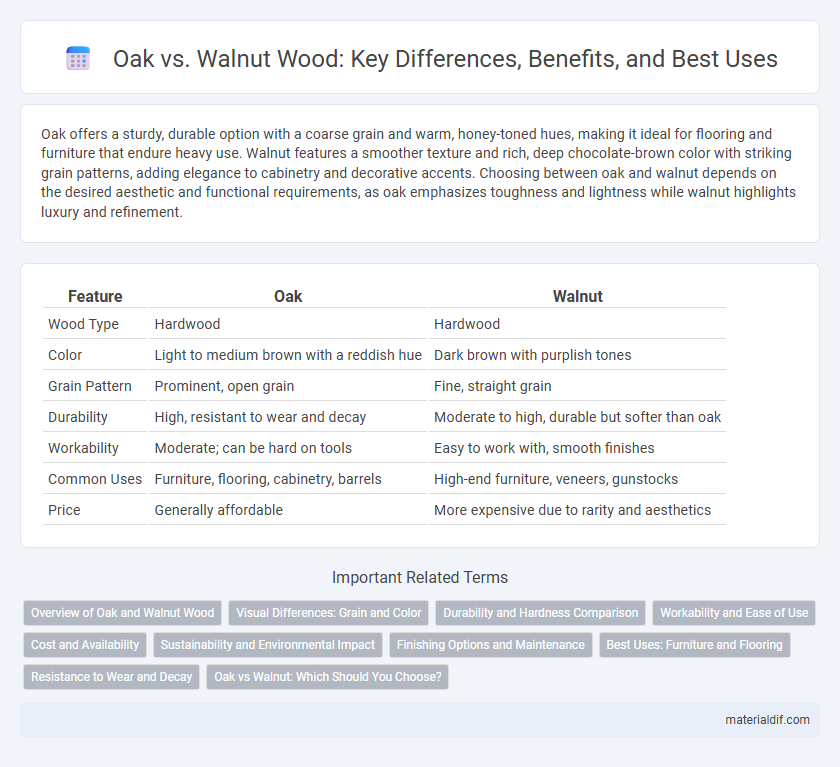Oak offers a sturdy, durable option with a coarse grain and warm, honey-toned hues, making it ideal for flooring and furniture that endure heavy use. Walnut features a smoother texture and rich, deep chocolate-brown color with striking grain patterns, adding elegance to cabinetry and decorative accents. Choosing between oak and walnut depends on the desired aesthetic and functional requirements, as oak emphasizes toughness and lightness while walnut highlights luxury and refinement.
Table of Comparison
| Feature | Oak | Walnut |
|---|---|---|
| Wood Type | Hardwood | Hardwood |
| Color | Light to medium brown with a reddish hue | Dark brown with purplish tones |
| Grain Pattern | Prominent, open grain | Fine, straight grain |
| Durability | High, resistant to wear and decay | Moderate to high, durable but softer than oak |
| Workability | Moderate; can be hard on tools | Easy to work with, smooth finishes |
| Common Uses | Furniture, flooring, cabinetry, barrels | High-end furniture, veneers, gunstocks |
| Price | Generally affordable | More expensive due to rarity and aesthetics |
Overview of Oak and Walnut Wood
Oak wood is known for its strength, durability, and coarse grain, making it ideal for furniture and flooring. Walnut wood features a rich, dark color with a smooth, fine grain that is prized for high-end cabinetry and decorative veneers. Both woods are hardwoods valued for their aesthetic appeal and long-lasting performance in woodworking projects.
Visual Differences: Grain and Color
Oak wood features a prominent, open grain pattern with visible rays and a light to medium brown color that often includes golden or reddish hues. Walnut exhibits a finer, more uniform grain with occasional wavy or curly figures, showcasing a rich, dark brown to purplish-black color that deepens with age. The distinct color contrast and grain texture between oak and walnut influence their aesthetic applications in furniture and interior design.
Durability and Hardness Comparison
Oak wood exhibits superior hardness with a Janka rating of approximately 1,290 pounds-force, making it an excellent choice for high-traffic flooring and furniture durability. Walnut, rated around 1,010 pounds-force, offers moderate hardness but excels in dimensional stability and resistance to wear over time. Both hardwoods provide substantial durability, though oak's higher density and grain structure contribute to its enhanced resilience against dents and impacts.
Workability and Ease of Use
Oak offers excellent workability due to its coarse texture and rigidity, making it ideal for furniture and flooring projects that require durability. Walnut's fine, straight grain and moderate hardness allow for smooth machining and finishing, favored in detailed woodworking and cabinetry. While oak is tougher to bend and shape, walnut provides superior ease of use in carving and intricate designs.
Cost and Availability
Oak wood generally offers a more affordable price point compared to walnut, making it a popular choice for budget-conscious projects. Oak is widely available across North America and Europe, ensuring steady supply and lower costs due to its abundance. Walnut, prized for its rich color and grain, commands a higher price and is less readily available, which can increase costs and lead times for sourcing.
Sustainability and Environmental Impact
Oak and walnut differ significantly in sustainability and environmental impact, with oak being more abundant and faster-growing, which promotes better forest regeneration and reduces deforestation risks. Walnut trees, prized for their rich color and grain, typically grow slower, demanding longer periods before harvest and potentially increasing ecological strain. Choosing oak supports more sustainable forestry practices by balancing commercial use with ecosystem preservation and lower carbon footprints.
Finishing Options and Maintenance
Oak offers versatile finishing options, including stains, oils, and polyurethane, enhancing its natural grain and providing durable protection suitable for high-traffic areas. Walnut, prized for its rich, dark color and smooth grain, takes to oil-based finishes exceptionally well, highlighting its depth while requiring regular maintenance to preserve its luster. Both woods benefit from periodic cleaning and refinishing, but oak's resilience makes it easier to maintain over time compared to walnut's need for careful upkeep to prevent surface wear.
Best Uses: Furniture and Flooring
Oak offers durability and a strong grain pattern that makes it ideal for high-traffic flooring and traditional-style furniture, providing long-lasting performance and a classic aesthetic. Walnut features a rich, dark color with a fine, straight grain, making it perfect for elegant, high-end furniture pieces and flooring that adds a touch of sophistication and warmth to interiors. Both woods excel in wear resistance, but oak's hardness suits heavy-use areas better, while walnut's luxurious finish suits decorative applications.
Resistance to Wear and Decay
Oak demonstrates exceptional resistance to wear and decay due to its dense grain structure and high tannin content, which acts as a natural preservative. Walnut, while durable, is comparatively softer and more prone to wear over time, but it resists fungal decay effectively due to its moderate natural oils. For applications demanding long-lasting durability, oak is generally preferred for its superior toughness and decay resistance.
Oak vs Walnut: Which Should You Choose?
Oak offers exceptional hardness and durability, making it ideal for furniture and flooring that withstand heavy wear, while walnut is prized for its rich, dark color and smooth grain, lending an elegant, luxurious appearance. Oak's golden to light brown tones contrast with walnut's deep chocolate hues, impacting design choices based on aesthetic preference and room ambiance. Choosing between oak and walnut depends on desired durability, color depth, and application, with oak preferred for robustness and walnut favored for sophisticated interior accents.
Oak vs Walnut Infographic

 materialdif.com
materialdif.com